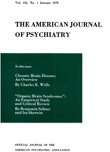CHANGES IN SYMBOLIC EXPRESSION WITH AMYTAL SODIUM
Abstract
1. Attitudes toward and recognition of illness and hospitalization were studied before and during the intravenous administration of amobarbital sodium. Changes in language patterns and nonverbal aspects of behavior were compared in 50 patients with pre-existing brain disease and a like number of normal subjects with comparable disabilities.
2. Prior to receiving the drug, all patients expressed awareness of illness, were completely oriented for place, and identified the examiners correctly. With the drug, explicit denial of illness, disorientation for place, and gross misidentification of the examiners occurred only in some of the patients with brain damage. In the normal group, subjects talked of illness in terms of a third person, used more "concrete" symbols, selectively misinterpreted questions about illness and misnamed the examiners in "paraphasic" fashion.
3. Amobarbital sodium did not necessarily make patients more communicative. Thirty patients in both groups showed no changes in verbal or nonverbal behavior. Some talked more, others less.
4. Euphoria was noted in II patients in the normal group and in 17 with brain disease. The euphoria frequently alternated with paranoid and depressed attitudes. It was not related to the dosage of the drug and in some instances came on after the interview was terminated. Ludicrous aspects of behavior were prominent.
5. The euphoria, drowsiness, dysarthria, and dystaxia produced, unlike the nystagmus, cannot be explained in terms of any particular neurophysiologic mechanism of action of barbiturates but must be considered in symbolic as well as physiological concepts.
6. Amobarbital sodium, given under the conditions described, appeared to provide a milieu of brain function in which not new motivations but new symbolic forms for their expression could be evolved and maintained. These are best interpreted not in terms of "release of repressed material" but as an adaptive, more effective defense in a situation of greater stress.
7. The productions of patients under the influence of amobarbital sodium should be interpreted not only in a factual referential context but as a symbolic representation of wishes and feelings expressed in personal, spatial, and temporal terms.
8. The observed behavior could not be explained in physiological or psychophysiological terms as "cortical depression" or "release of inhibition." It is suggested that much of the behavior ascribed to such mechanisms may be largely manifestations of a particular observer-subject relationship.
Access content
To read the fulltext, please use one of the options below to sign in or purchase access.- Personal login
- Institutional Login
- Sign in via OpenAthens
- Register for access
-
Please login/register if you wish to pair your device and check access availability.
Not a subscriber?
PsychiatryOnline subscription options offer access to the DSM-5 library, books, journals, CME, and patient resources. This all-in-one virtual library provides psychiatrists and mental health professionals with key resources for diagnosis, treatment, research, and professional development.
Need more help? PsychiatryOnline Customer Service may be reached by emailing [email protected] or by calling 800-368-5777 (in the U.S.) or 703-907-7322 (outside the U.S.).



